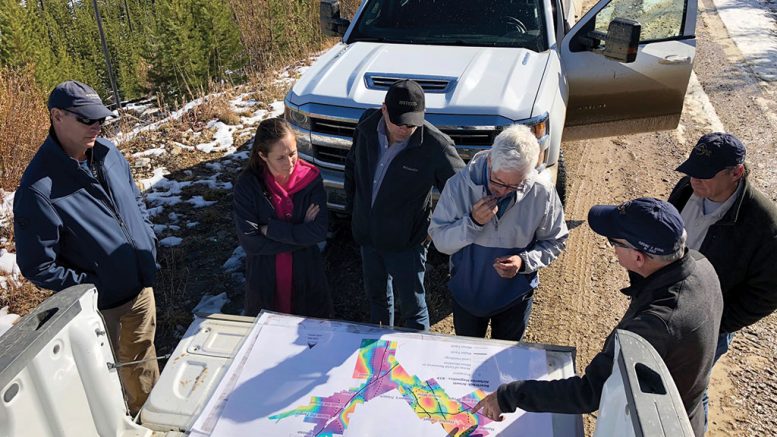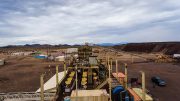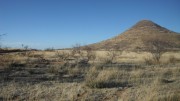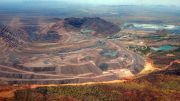The southwestern United States has a long-standing history of mining and remains one of the nation’s top mineral regions. With existing infrastructure, an established regulatory and permitting regime and prospective geological terrain, many companies in the exploration space have a renewed interest in this destination. Below, we present eight companies active in the southwest United States.
Bunker Hill Mining

A view from the historic Bunker Hill zinc-lead-silver property in Idaho. Credit: Bunker Hill Mining.
Bunker Hill Mining (CSE: BNKR; US-OTC: BHLL) is working to restart the historic Bunker Hill mine in the Coeur d’Alene mining district of northern Idaho. The operation historically generated over 35 million tonnes between 1885 and 1991, grading 8.76% lead, 3.67% zinc and 55 grams silver per tonne.
The developer sees substantial exploration upside across the property, with targets around known and mined mineralization, and at depth, below the existing workings, high-grade silver is the primary exploration target. After bringing the mine back online, the company would mill the mineralized material, either on-site or at a third-party facility, to generate lead-silver and zinc concentrates, which would be shipped to smelters for processing.
This year, the company announced several changes to its management team, naming Sam Ash president and chief executive in April, and, in October, appointing James Stonehouse as vice president of exploration.
In September, the company released a resource estimate for the property and started a 4,570-metre exploration campaign. The initial inferred resource stands at 8.9 million tons, grading 1.27 silver oz. per ton, 2.31% lead and 4.97% zinc, for a total of 11.2 million oz. silver, 409.6 million lb. lead and 879.7 million lb. zinc.
In October, Bunker Hill also reported near-surface, high-grade silver intercepts from its namesake mine, nearby existing infrastructure. Drill highlights include 8 metres of 165.52 grams silver; 5 metres of 126.56 grams silver; and 2 metres of 178.72 grams silver. According to Ash, these intercepts support the company’s thesis of significant high-grade silver mineralization at Bunker Hill.
In August, Bunker Hill closed a $20.4-million private placement. The net proceeds will be used to explore the high-grade silver potential of the Bunker Hill mine, as well as for payments required to keep the option interest in good standing.
Bunker Hill Mining has a mining lease with option to purchase agreement for the mine with privately held Placer Mining, which extends out to August 2022. It may purchase the asset for US$5.9 million in cash and US$4.8 million in shares. While the lease is in effect, monthly payments of US$60,000 are due.
Bunker Hill Mining has a $67.4-million market capitalization.
Crown Mining

Crown Mining’s Moonlight-Superior property in northeastern California. Credit: Crown Mining.
Crown Mining (TSXV: CWM) is working to advance its 39-sq.-km Moonlight-Superior copper project in northeast California’s Plumas county. The project is within the past-producing Lights Creek copper district, which generated approximately 161 million lb. copper between 1915 and 1930 from the Superior and Engels mines. Placer Amex explored the property between 1960 and 1972 and drilled over 400 holes at the site.
There are three iron-oxide-copper-gold deposits at the site: Moonlight, Superior and Engels. Moonlight features 154 million indicated tonnes grading 0.29% copper and a further 62 million inferred tonnes of 0.29% copper. Superior includes an inferred resource of 57 million tonnes at 0.41% copper. At Engels, oxide inferred resources consist of 2.5 million tonnes at 1.05% copper. Each of the three deposits includes prospects for resource expansion with drill-ready oxide and sulphide targets nearby.
The historic work completed by Amex defined near-surface oxide copper material at Moonlight, with thicknesses estimated at 18 to 24 metres.
A preliminary economic assessment (PEA) published in 2018 for the Moonlight deposit outlines a 17-year, 54,431-tonne-per-day open-pit operation, producing 1.5 billion lb. copper at total life-of-mine operating costs of US$7.04 per tonne. With an initial capital cost estimate of US$513 million, the after-tax net present value estimate for the project, at an 8% discount rate and based on US$3.15 per lb. copper, is US$179 million, with a 14.6% internal rate of return.
The above numbers exclude any potential upside from the processing of an oxide cap at Moonlight.
Crown has identified additional opportunities for resource growth at the Blue Copper, Copper Mountain, Osmeyer, Lamb’s Ridge and Warren Creek areas within the project grounds.
In August, Crown Mining announced the results of a historic exploration data review on the Superior deposit. Key takeaways include potential for resource growth based on higher-grade copper-silver, and gold, mineralization identified in at least ten veins and breccia zones. Less than half of the copper-in-soil anomaly has been tested at Superior.
The junior is looking to partner with a copper miner to advance its key asset.
Crown Mining has a $4.9-million market capitalization.
Fiore Gold

A haul truck placing ore on the leach pad at Fiore Gold’s Pan gold mine in Nevada. Credit: Fiore Gold.
Fiore Gold (TSXV: F; US-OTC: FIOGF) is a gold producer, whose flagship asset is the Pan heap leach mine in Nevada, on the Battle Mountain-Eureka gold trend. The company also holds the Gold Rock and Golden Eagle projects in Nevada and Washington, respectively.
Fiore has been operating Pan since 2018 and has steadily been increasing its gold output. Over the course of the company’s 2020 fiscal year, which ended on Sept. 30, the producer generated 46,031 gold oz., in line with its guidance for 45,000-48,000 ounces. This compares with 41,491 oz. recorded in fiscal 2019. Production growth is largely attributable to increased recoveries from a primary crusher installation.
Alongside the growing gold output from Pan, Fiore has seen its cash balance grow. At the end of September, the miner had a cash balance of US$23.2 million, an increase of US$5.9 million over the end of June, and an increase when compared with the US$15.9 million in the bank on Sept. 30, 2019.
With potential to increase throughputs and add to the resource base, Fiore sees further upside at the asset.
The satellite Gold Rock holding, together with Pan, covers a contiguous, 200-sq.-km land package and is federally permitted. In April, the company announced the results of a PEA, which outlines an open pit operation that shares infrastructure and management with Pan.
As a 9,070-tonne-per-day heap leach operation, Gold Rock could generate an additional 55,800 oz. gold annually for the company over a 6.5-year mine life, at all-in sustaining costs (AISCs) of US$1,008 per ounce. With a pre-production capital estimate of US$64.6 million, the after-tax net present value estimate for the incremental development comes in at US$32.8 million, at a 5% discount rate and based on US$1,400 per oz. gold, with a 17.8% internal rate of return. Fiore is now working to complete a feasibility study for Gold Rock by the second half of 2021.
In May, the miner also tabled an updated resource estimate for Golden Eagle, which lies within the Republic-Eureka mining district.
At a 0.48 gram gold cutoff, Golden Eagle holds measured and indicated resources of 45.4 million tonnes, grading 1.38 grams gold and 6.44 grams silver, containing 2 million oz. gold and 9.4 million oz. silver. Additional inferred resources feature 5.4 million tonnes, at 0.9 gram gold and 4.43 grams silver, for a further 154,650 oz. gold and 764,990 oz. silver. Kinross’ (TSX: K; NYSE: KGC) 1,800-tonne-per-day Kettle River mill, on care and maintenance, is 10 km away from the project.
Fiore Gold has a $156.3-million market capitalization.
Gold Standard Ventures

Looking north at a drill rig on Gold Standard Ventures’ Dark Star gold deposit in Nevada. Credit: Gold Standard Ventures.
Gold Standard Ventures (TSX: GSV; NYSE: GSV) is looking to develop a starter oxide gold operation at the South Railroad project, within the wholly owned 208-sq.-km Railroad-Pinion project on the Carlin trend in Nevada. According to Gold Standard, the trend “hosts one of the largest gold concentrations in the western hemisphere” and includes established oxide and refractory gold deposits, as well as producing mines.
In February, the company published an updated pre-feasibility study (PFS) for South Railroad, with open-pit operations at the Dark Star and Pinion deposits and heap leach gold extraction. The combined eight-year operation would place an average of 156,000 oz. gold annually on the heap leach pad, with gold recoveries estimated at 72-76%. With life-of-mine AISCs estimated at US$707 per oz., and an initial capital cost estimate of US$132.9 million, the after-tax net present value estimate of the project is US$265 million, at US$1,400 per oz. gold, US$17.11 per oz. silver and using a 5% discount rate, with a 40% internal rate of return.
Gold Standard plans to deliver a feasibility study for the project in June of next year.
Total resources across Railroad-Pinion include the Dark Star, Pinion, Jasperoid Wash and North Bullion deposits. The measured and indicated inventory includes 64.6 million tonnes, at 0.75 gram gold, for a total of 1.6 million oz. gold, with a further 34.8 million inferred tonnes, at 1.07 grams gold, containing 1.2 million oz. gold.
In addition to the current mineralization, the company is looking to add to its resource base. At Jasperoid Wash, there is potential to expand the shallow oxide mineralization to the east and north, with additional soil anomalies to the south. The Pod-Sweet Hollow oxide zone, to the north of South Railroad, also indicates potential for additional oxide resources.
In November, the company reported reverse circulation (RC) drill results from its 2020 Pinion deposit development program, which suggest a new higher-grade oxide zone at Pinion. Oxide drill highlights included 78 metres of 2.24 grams gold and 38 metres of 4.37 grams gold. Jonathan Awde, the company’s chief executive, said the new Pinion zone “has the best oxide gold grades we have ever drilled at Pinion and it has potential to expand.”
In addition, Gold Standard also holds the 21.6-sq.-km Lewis project, 100 km west of South Railroad, on the Battle Mountain-Eureka trend, and adjacent to Nevada Gold Mines’ Phoenix mine. The property includes an inferred resource of 7.7 million tonnes, at 0.83 gram gold and 14.22 grams silver, which contains 205,827 oz. gold and 3.5 million oz. silver.
Gold Standard Ventures has a $280.5-million market capitalization.
Nevada Copper

The Pumpkin Hollow copper mine in Nevada. Credit: Nevada Copper Corp.
Nevada Copper (TSX: NCU; US-OTC: NEVDF) is focused on ramping up its Pumpkin Hollow underground copper mine in Nevada, 12 km outside of the city of Yerington.
According to a corporate update provided at the beginning of November, the company has completed the steelwork for the Main shaft, and started its staged commissioning, and is working to reach the 5,000-tonne-per-day nameplate level. The mill ramp up appears to be going well, with sustained periods of operations around the 5,000-tonne-per-day capacity, and ongoing copper concentrate deliveries to its offtaker. Underground, lateral development is underway, with average October stope development grades of 2% copper-equivalent.
Based on an update to its geotechnical parameters in August, Nevada Copper has made changes to some stope dimensions in the Upper East South zone. These include smaller stopes during the ramp-up period, leading to larger stopes starting in the first quarter of next year. The smaller stopes in the short-term have increased the company’s near-term cost projections. As a result, Nevada Copper anticipates that it will need additional funding over the coming months as it completes the ramp-up. Discussions are underway with a senior bank lender, and the company has also received a third-party term sheet for an additional credit line of US$20 million to US$30 million.
A 2019 PFS for Pumpkin Hollow outlines a stand-along underground operation at the site, with additional development options for an open pit.
According to the PFS, the 13.5-year underground mine would produce an average of 50 million lb. copper, 8,000 oz. gold and 150,000 oz. silver each year over its lifetime, at AISCs of US$1.96 per lb. copper. The resulting post-construction after-tax net present value estimate, at a 5% discount rate, is US$301 million, with a 25% internal rate of return.
The potential 19-year pit development, which would operate at approximately 33,600 tonnes per day in its first six years, followed by an optional expansion to 63,500 tonnes per day, would extract an additional 350 million tonnes over its life, at 0.5% copper-equivalent. This project, with a pre-production capital cost estimate of US$672 million, would generate US$829 million in after-tax net present value, at a 7.5% discount rate, with a 21% internal rate of return.
The company is working to advance the open pit project to the feasibility stage, with a construction decision expected to follow.
Nevada Copper has a $119-million market capitalization.
Revival Gold

A drill at Revival’s Beartrack gold project in Idaho. Credit: Revival Gold.
Revival Gold (TSXV: RVG; US-OTC: RVLGF) is working to deliver a PEA by year-end for its 54-sq.-km, past-producing Beartrack-Arnett project in Idaho.
The 27.2-sq.-km Beartrack portion of the property operated as an open pit, heap leach operation between 1994 and 2000, producing approximately 600,000 oz. gold over this time. The site hosts infrastructure from the historic mine, including power lines, roads, a processing plant and a core facility.
In October, Revival released assay results for seven holes completed at the Haidee target area at Arnett, all of which hit near-surface, leachable mineralization along extensions of the Haidee deposit. The drill highlights include 23 metres of 0.63 gram gold; 41 metres of 0.38 gram gold; and 10 metres of 0.3 gram gold. According to the company, the results extended known mineralization by 100 metres to the northeast and 50 metres to the southeast.
In February, the company released an updated resource for Beartrack-Arnett, with 36.4 million indicated tonnes, at 1.16 grams gold, containing 1.4 million oz. gold, and 47.2 million inferred tonnes, at 1.08 grams gold, for a further 1.6 million ounces. These resources include both heap leach and mill processing material; the latter includes open-pittable and underground material.
Of note, the resources in the heap leach category across the two properties total 14.2 million tonnes, grading 0.58 gram gold, for 264,000 oz. gold. Inferred resources add 18.3 million heap-leachable tonnes to the company’s inventory, at 0.54 gram gold, for a further 316,000 oz. gold.
The PEA is looking at a restart of heap leach operations at the site. Revival plans to start a PFS on the project next year.
With a 10,000-metre drill program underway at Beartrack-Arnett, the company sees the potential to grow its mineral inventory. At Beartrack, the mineralized trend covers over 5 km and remains open. At Arnett, mineralization also remains open. Together, the two adjacent properties host over 10 km of favourable structure.
Last year’s bottle roll tests, completed on Arnett material, suggest gold heap leach recoveries of 75%.
In August, the company closed a $15-million bought deal financing.
Revival Gold has a $72.6-million market capitalization.
Silver One Resources

Silver One Resources’ Candelaria project in Nevada. Credit: Silver One Resources.
Silver One Resources’ (TSXV: SVE; US-OTC: SLVRF) flagship asset is the past-producing Candelaria silver mine in Nevada, 209 km southeast of Reno. The property is within the Candelaria mining district, which, between the late 1880s and 1954, generated 22 million oz. silver. Between 1980 and 1999, open-pit operations at the site generated an estimated 47 million oz. silver.
In August, the company tabled an updated resource estimate for the heap leach pads at Candelaria. Indicated resources stand at 22.2 million tonnes, grading 42.1 grams silver, and contain 30 million oz. silver with an additional 11.5 million inferred tonnes, at 41.8 grams silver, for a further 15.4 million silver ounces.
In addition to the heap leach resource, the site hosts historic resources within the Mount Diablo and Northern Belle pits.
Silver One is looking to complete an economic study on reprocessing material on the historic heap leach pads, and on combining additional near-surface mineralization with the heap leach material.
In October, the company started a 15,000-metre RC drill program at the property. The drill material will also be used for metallurgical testing of the near-surface mineralization around the two pits.
The three main targets for drill testing include a 1,500-metre by 500-metre area with potential for high-grade mineralization down-dip of the two historic pits; extensions of the near-surface mineralization; and potential skarn IOGC (iron oxide copper-gold) mineralization identified in historic underground workings.
Silver One has the option to acquire a 100% interest in Candelaria. To do so, it will need to issue US$100,000 worth of its units (consisting of one share and half of a warrant) to each of SSR Mining (TSX: SSRM; NASDAQ: SSRM) and Maverix Metals (TSX: MMX; NYSE: MMX) and make a US$1 million payment to Maverix (cash and shares) one year after the start of commercial production at a rate of 2.5 million oz. silver annually from Candelaria.
The company also wholly owns the Cherokee epithermal silver-copper-gold project in Nevada and has the option to acquire a 100% stake in the Phoenix silver project in Arizona.
Silver One Resources has a $147.3-million market capitalization.
West Vault Mining
West Vault Mining (TSXV: WVM) wholly owns the Hasbrouck gold project in Nevada, located between Reno and Las Vegas and along the Walker Lane gold trend. From West Vault’s website, Hasbrouck is one of the few shovel-ready gold projects in the southwestern United States.
The Hasbrouck project includes three deposits: Hasbrouck, Three Hills and Hill of Gold. The company acquired the third resource at the end of 2018.
According to West Vault, Hasbrouck and Three Hills, 8 km apart, are near-surface oxide deposits, amendable to open-pit heap leach mining.
A PFS from 2016 on a development of the Hasbrouck and Three Hills deposits suggests a 16,000-tonne-per-day operation, which would first operate the Three Hills mine for two years, and then mine Hasbrouck for six years. The resulting project would produce an average of 74,000 oz. gold-equivalent annually, at AISCs of US$709 per ounce.
With an initial capital cost estimate of US$47 million, and US$83 million required in growth capital for the Hasbrouck mine, the after-tax net present value estimate for the development is US$120 million, at a 5% discount rate and based on US$1,275 per oz. gold and US$18 per oz. silver, with a 43% internal rate of return.
The combined reserves across Hasbrouck and Three Hills is 45.3 million tonnes grading 0.017 oz. per ton gold and 0.233 oz. per ton silver, for a total of 762,000 oz. gold and 10.6 million oz. silver.
At Three Hills, the first proposed pit is fully permitted. Earlier this month, West Vault also received a Decision Record (DR) and a Finding of No Significant Impact from the Bureau of Land Management, based on an analysis of the Environmental Assessment (EA) for the Hasbrouck mine.
According to West Vault, the DR indicates that the company has completed the requirements under the National Environmental Policy Act and the EA process, and is the last major permitting milestone before allowing construction of the second-phase open pit.
In July, the company consolidated its interest in the Hasbrouck project. West Vault purchased a 25% stake in the asset from Waterton Precious Metals Fund for US$10 million in cash, and issued 1 million common shares to Waterton for the transaction.
West Vault Mining has a $106.6-million market capitalization.






Be the first to comment on "Southwest US snapshot: Eight companies active in the region"